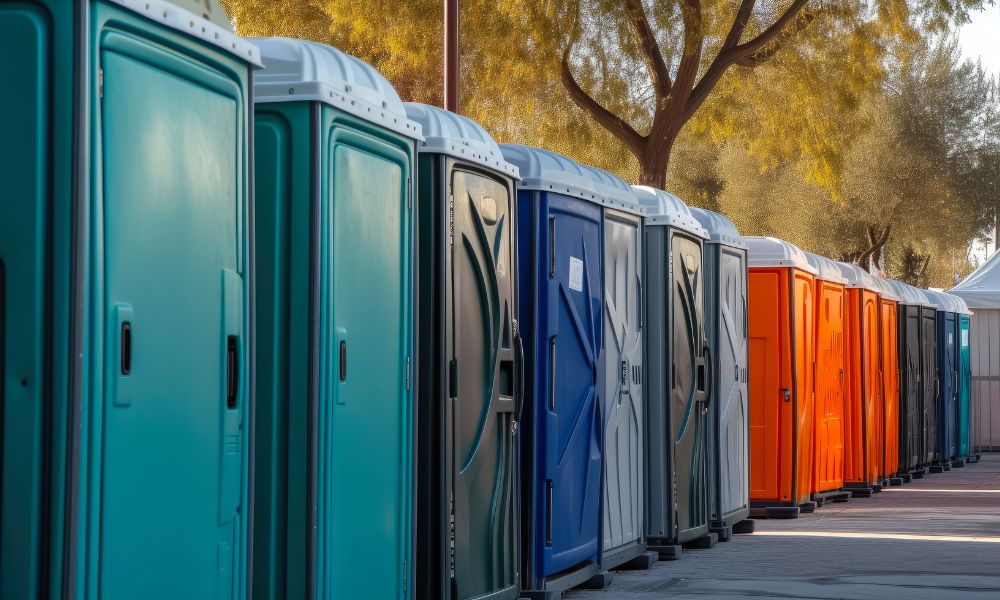Imagine attending a bustling outdoor festival or working on a sprawling construction site without the convenience of a porta potty nearby. Hard to picture, right? Yet, before these now ubiquitous fixtures graced our outdoor events and work sites, folks had to get creative with their bathroom solutions.
The history of porta potties, from a necessity to an innovation, reflects a fascinating slice of history. These life-saving contraptions blend human ingenuity with the evolution of public health standards. Stick with us as we take a trip through the historical journey of porta potties.
Reasons for Inventing the Porta Potty
The invention of the porta potty emerged from a blend of necessity and ingenuity. As urban populations grew and public events became more widespread, the need for accessible, clean, and temporary restroom facilities became apparent.
Moreover, the burgeoning construction industry, with its transient worksites, underscored the demand for a practical bathroom solution that could move with the workforce. The porta potty answered these needs, providing a sanitary and convenient option for people on the go.
What Did People Use Before Porta Potties?
Before the advent of porta potties, options were limited and often less than ideal. In rural areas, outhouses were common, while city dwellers might have used public restrooms where available.
Large gatherings and construction sites posed challenges, often resorting to makeshift solutions like those wooden boxes or, worse, the great outdoors. The introduction of porta potties revolutionized these scenarios, offering a semblance of privacy and hygiene that was previously hard to come by.
How Did Porta Potties Get Their Name?
The term “porta potty” itself is a testament to the portability and purpose of these essential facilities. “Porta” comes from the word portability, highlighting the key feature that sets porta potties apart from their stationary counterparts.
The “potty” part is self-explanatory. Together, they succinctly capture the essence of what these units offer: a portable bathroom solution that you can place wherever and whenever you need it.
1800s: Wooden Boxes & Sawdust Filling
Back in the 1800s, the predecessors of our modern porta potties were rather rudimentary. People relied on wooden boxes filled with sawdust or other absorbent materials to take care of business.
These makeshift loos required regular emptying and cleaning—a task not for the fainthearted. Yet, they represented a critical step toward more sanitary public spaces and work environments, laying the groundwork for the portable bathrooms we know today.
1950s: The Invention of the Modern Porta Potty
The 1950s marked the dawn of the modern porta potty, revolutionizing how we think about and use these temporary restrooms. With the advent of lightweight, durable plastics, manufacturers produced porta potties that were easy to transport and simple to clean and maintain.
This era introduced features such as chemical deodorizers and more sophisticated waste containment methods, significantly improving the user experience.
1960s and 1970s: Fiberglass & Polyethylene Porta Potties
In the swinging sixties and the groovy seventies, the world saw the porta potty become even more popular. Originally crafted from fiberglass, these early models were heavy, more difficult to transport, and prone to odor retention. They were less than ideal for major events and larger gatherings.
However, the industry soon shifted to polyethylene, a lighter and more odor-resistant material. This change significantly improved the porta potty experience, making these units easier to transport and more pleasant to use.
It was the era of innovation, and the porta potty was a basic yet essential fixture at outdoor events and construction sites.
1980s: Luxury Porta Potties Increase in Popularity
As we moonwalked into the 1980s, the concept of the porta potty took a glamorous turn. Enter the luxury porta potty, complete with flushing toilets, running water, and air conditioning, among other fabulous amenities.
These upscale units catered to weddings, corporate events, and any occasion where a typical porta potty wouldn’t be a cohesive part of the experience.
The 1980s showed us that luxury and convenience could coexist even in the most unlikely places, transforming our thinking about portable restrooms.
1990s: ADA-Compliant Porta Potties Become Necessary
The 1990s brought a wave of inclusivity with the introduction of ADA-compliant porta potties. This important evolution ensured that everyone, regardless of mobility, could have access to comfortable and convenient restroom facilities.
Featuring wider doors, handrails, and more spacious interiors, these units demonstrated the industry’s commitment to accessibility and the equal opportunity enjoyment of outdoor events and gatherings.
How Modern Technology Has Impacted the Porta Potty Industry
Fast forward to today, and modern technology has taken the porta potty experience to new heights. Solar-powered lighting, hands-free faucets, and Wi-Fi connectivity have become part of the package, reflecting our society’s broader technological advancements.
These innovations enhance user comfort, improve hygiene, and promote sustainability, proving that even the most traditional services can benefit from a tech-savvy makeover.
Major Differences Between Modern & Old-School Porta Potties
Comparing modern and old-school porta potties highlights the revolution in design, functionality, and user experience. Gone are the days of the simple, odor-trapping fiberglass units.
Modern porta potties boast materials that resist odors and bacteria, technology that conserves water and promotes cleanliness, and designs that ensure comfort for all users.
It’s a testament to human ingenuity that we’ve managed to turn a basic utility into a sophisticated, eco-friendly solution that meets a variety of needs.
As we wrap up this stroll down memory lane, it’s clear that the history of porta potties is more than a tale of toilets. From a wooden box filled with sawdust to a modern, feature-packed portable bathroom from Floods Royal Flush, porta potties have evolved in response to our changing needs and environments.
They remind us why innovation and overcoming challenges are so important to our quality of life, especially when it comes to simple, necessary conveniences such as restroom access. The next time you find yourself reaching for that sanitizer pump in a sophisticated porta potty, take a moment to appreciate the history of porta potties and their journey from a necessity to an innovation.



